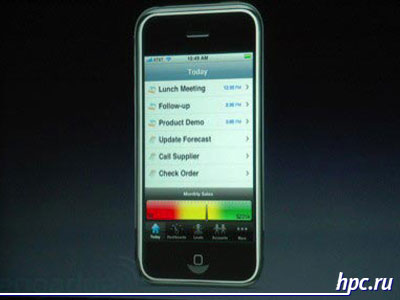Last week the best news came from the CeBIT 2008, which was held from 4 to 9 March in Hanover. Despite pessimistic forecasts about the wilting exhibition, this year she broke a result of the previous year in attendance. Recall that last year, CeBIT was ignored, for example, companies such as Nokia and Motorola. To save face and overcome the drop in popularity of CeBIT, the organizers had to substantially change the format of the exhibition. Now it has become much more focused on business interests, not consumers. As a result, at CeBIT 2008 was presented a set of new technologies and solutions, but in the vast flow of news about computer components were much less willing to "Last Seen" and interesting to ordinary users, not interested in IT-industry professional.
Image and speed ASUS
Company ASUSTeK, perhaps, be called the champion among the well-known manufacturers by the number of mobile innovations presented at CeBIT. In the first place, catches the eye two new devices that were released under the brand automobile concern Lamborghini. ASUS-Lamborghini VX3 simply extends the line "racing" notebook, but the ASUS-Lamborghini ZX1 opens a new direction in cooperation companies. This is the first device, submitted under the name ASUSTeK ASUS-Lamborghini. As expected, there are a lot of attention was paid to style and design, with both hardware and software parts. Communicator in classic candybar form factor, but it looks at this original and attractive. The body uses materials such as carbon fiber and stainless steel.
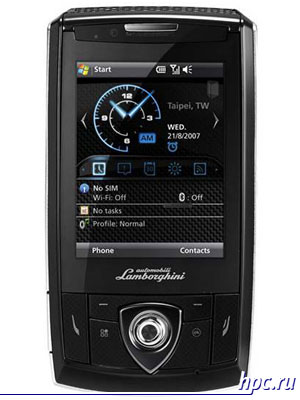 |
| ASUS-Lamborghini ZX1 |
Inland charm promotes the proprietary graphical user interface, oriented under the control of the fingers. The interface uses a three-dimensional graphics capabilities, easily customizable and provides quick access to screen Today, business and entertainment functions, thanks to modernized menu Multi-Home & Anytime. Provides even a function similar to the cover flow from Apple products to work with multimedia content. Interface allows you to manage various flourishes, for example, you can rotate and zoom in just leading a finger across the screen. All this is based on the operating system Windows Mobile 6.1 Professional, which has not yet been brought to Microsoft officially. Interestingly, the new interface will be used not only in the communicator ASUS-Lamborghini, but also some other updates to ASUS, producer did not "pinch" as a convenient innovation for fashion phones.
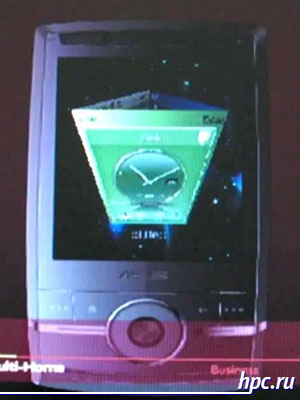 |
| Graphical user interface ASUS-Lamborghini ZX1 |
Nevertheless, in its tactical and technical characteristics of the ASUS-Lamborghini ZX1 can be described as "outstanding, and only". ASUSTeK clearly does not rely on a long, beautiful sheet of record-breaking parameters, which would have been so attractive to tehnomanov. Instead, it offered just enough well-balanced functionality. Tri-band third-generation networks up to the standard HSDPA (speed of 3.6 Mbps), plus full support for four-band GSM / GPRS / EDGE, wireless Sete Wi-Fi (802.11 b / g) interface and Bluetooth 2.0 + EDR. Frankly, not every top-end smartphone boasts such a large scale in communication talents, and among the products are ASUS, until recently, was a unique combination. The heart device is a TI 2431 processor with 450 MHz. Built-in memory reaches 128 MB RAM and 256 MB ROM. The camera has a resolution of 3 megapixel auto-focus function is supported. Certainly, a functionality of GPS-navigation.The standard 2.8-inch display with QVGA (320x240 pixels), even a few out of the general picture "above average". Judging by the preliminary reviews, visitors stand a few guards selected in the specification lithium-ion battery with 1150 mAh, but it's hard to imagine a person who bought the ASUS-Lamborghini ZX1, which would have long used the device from outside the home, office or car, where it is easily recharged.
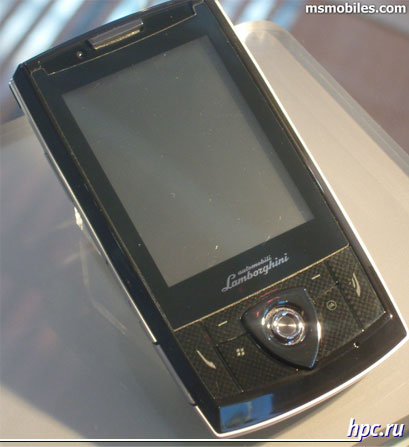 |
| ASUS-Lamborghini ZX1 |
Small device can not be named, but it's pretty thin and lightweight. Sizes reach 115,6 x59, 4x13, 2 mm, and weight - 119 grams with battery. For comparison, a third generation Communicator ASUS P735 (GPS-without module) size is 109h59h19 mm, weight - 143 grams. As we can see, the novelty is slightly longer but much thinner and lighter. The device is specifically designed for connoisseurs and lovers of beautiful design brands, it will be chosen on the principle of "like do not like" some shortcomings in the specification will be less important than a representative appearance. It is expected that the model will be released on the European market in May for about a thousand euros, that is about one thousand five hundred dollars. Communicator ASUS P560, also presented at the CeBIT 2008, is widely considered as "ASUS-Lamborghini ZX1 minus the show-off." The device is really very similar in specifications. Differences can be called only cosmetic. The body uses less material status, the design changed somewhat to a less pretentious, there is no influence of style Lamborghini. As a result of slightly increased size and weight of up to 116,4 x64, 2x13, 4 mm and 120.5 grams (with battery). Opportunity, he repeats the ASUS-Lamborghini ZX1, including communications functionality and a new proprietary interface. As the nearest competitor ASUS P560, perhaps, was the recent novelty from HTC - HTC Touch Cruise. It also focuses on the design, the new user-friendly interface and GPS-navigation. From the obvious differences can be identified lack of built-in FM-tuner model from ASUSTeK and more capacious battery for HTC Touch Cruise. The processor uses a Qualcomm MSM7200 400 MHz, how it differs to the actual performance of TI's 2431 show tests. The price of ASUS P560 is not known yet, but from her and from the date of issue depends on many things.
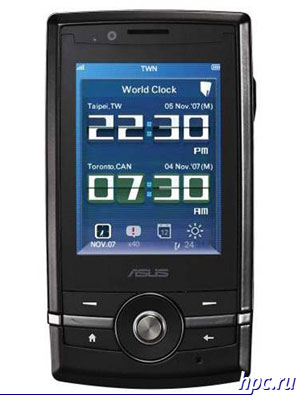 |
| Asus P560 |
ASUS M536 - it's unusual for ASUSTeK communicator. Immediately apparent that it is positioned apart, because it is not even attributed to a series of "P", in which up to this point consisted of all communicators ASUS, but in a series of M, which was represented by simple phones and smartphones. Since last year, manufacturers have started to develop the M-series as a business line, it has already got two smart phone with QWERTY-keyboard, and now came the turn of the communicator. In appearance and basic functions, which continues a long business smartphone ASUS M530w, submitted last year. He performed in the same candybar with QWERTY-keyboard and has the same target audience - users, many working with text in a mobile environment. Do ASUS M536 is one fundamental difference from the ASUS M530w. This is a communicator, not a smartphone, that is, there is touch screen and the work is performed under the operating system Windows Mobile 6.1 Professional with all the consequences. There are also a number of additional differences. The display has a resolution of 320x320 pixels and 320x240 pixels are not like M530w. Such a resolution is still very rare in Windows Mobile devices, although his support came back last year with the release of Windows Mobile 6. Then, it is equipped with integrated GPS-module, and therefore can be used for a variety of navigation services. Communications capabilities in new items more fully, for example, there is support for standards, EDGE and HSDPA, which is not supported in your smartphone. In addition, the increased amount of internal RAM-memory to 128 MB, but the processor is TI OMAP 2430, instead of the Marvell XScale PXA270. What is interesting dimensions to retain in the same framework, even become a bit less - 116,9 x62, 5x13, 9 mm. Special mention deserves fingerprint sensor, located on the site where users are usually accustomed to seeing the joystick. Communicator is considered a manufacturer as primarily a business device, so that the security of information here took care including hardware.
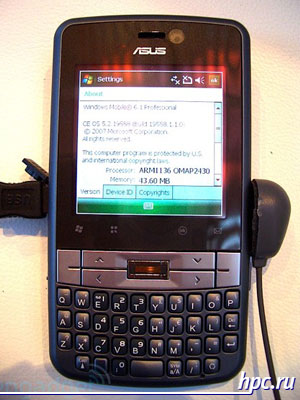 |
| ASUS M536 |
As the main competitor to ASUS M536 is likely to act as communicator Samsung SGH-i780, made in a similar form factor that supports the GPS-functionality and has the same rare resolution 320x320 pixels. Korean device a little bigger, but he has a little bigger display - 2.5 diagonal inches, not 2.4. Among other differences i780 can be called a 2-megapixel camera and processor Intel XScale PXA270 clocked at 520 MHz instead of 330 MHz. Among competing devices with similar ASUS M536 form factor - HP iPAQ 914 Business Messenger, i-Mate Ultimate 8502 and some others. It is expected that the novelty will appear this summer at an estimated price of 550 euros, that is about $ 850. The most modest of the presented new products at CeBIT 2008 - PDA ASUS P320. Early it was known under the code name ASUS Galaxy Mini. Unlike the three other communicators, it is focused on the middle or even the budget price segment. It does not support third-generation networks, based on a simple processor TI OMAP 850 200 MHz, equipped with an internal memory of 128 MB ROM and 64 MB of RAM. The main highlight of this model - tiny size and integrated GPS-module. With this combination of ASUS P320 may be regarded as an advanced competitor to HTC Touch. In size and weight of the ASUS P320 is quite comparable with the HTC Touch, but it has a noticeable advantage - GPS-enabled features. The only parameter on which he concedes HTC Touch is the screen size 2.6 inches diagonally, instead of 2.8. The expected cost is 300 euros, about $ 460. It is quite reasonable and competitive price.
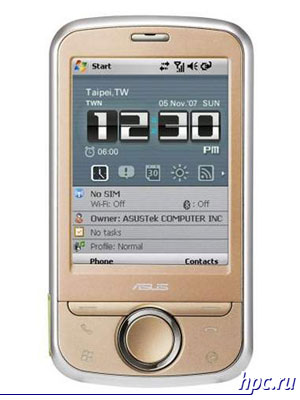 |
| Asus P320 |
Mysterious MDA compact IV
Of course, the company ASUSTeK was not the only manufacturer to show new mobile devices at CeBIT 2008. Quite interesting were stands of German operators. In Europe, it is common practice to purchase carrier versions of devices with a mandatory connection. Telecom operators are often exclusive mobile phones that can not be bought under a different brand, at least in the initial period of sales. The operator T-Mobile at this time did not change the established practice and introduced the communicator of the company HTC, which had previously not announced by the manufacturer. Communicator MDA compact IV is a dream come true for many Windows Mobile fans. Enumerating the characteristics of sounds like a song: the display with a resolution VGA (640x480 pixels), 4 GB of internal memory, extensive communications capabilities up to speed mobile standard HSDPA at speeds of 7.2 Mbps, 3-megapixel autofocus camera, GPS-functionality. All this in an attractive appearance, a very thin device.
| Issue 3 - March 7, "width =" 300 "height =" 400 "/> |
| T-Mobile MDA compact IV |
Main disappointment of journalists has become a rather strange approach to T-Mobile MDA compact IV presentation at the exhibition. Following the announcement, which took place just before the CeBIT 2008, the operator has failed to demonstrate a working device, and confined himself to the layout, and hidden from prying unnecessarily behind a glass showcase. As a result, more detailed features than were previously reported, were not known. Additional share of confusion have seen on the layout button "Home" and "Back", which are traditionally present on smartphones without touch-screen based on Windows Mobile Standard / Smartphone. While the entire line MDA compact was precisely because of communicators (with a touchscreen-based Windows Mobile Professional / PocketPC), its last representative MDA compact III - a well-known HTC Artemis. More nagging to study photos "zastekolnogo" layout with the exhibition confirms the presence of the slot for the stylus, so that the device definitely has a touch screen. Yes, and a parameter called VGA resolution while in Windows Mobile smartphones are not met. It is possible that the final version of the MDA compact IV will be different in appearance from the strange layout. Doubts dispelled, in May, when will the release of new items on sale, and possibly a little earlier, if HTC decides to issue a variation of the MDA compact IV under its own brand, without reference to the operator.
Hardy and clever workhorses
Pocket PC Getac PS535E will appeal to those who love to technique was capable of withstanding harsh environments. The device is protected from falling into the shell of dust and water to endure vibration and fall meets the MIL-STD-810F and IP54. Work is performed under the operating system Windows Mobile 5.0. Specifications quite good: there is support for Wi-Fi and Bluetooth, integrated GPS-module, 2 GB of internal flash memory, Samsung S3C2440A processor clocked at 400 MHz and 3.5-inch touchscreen display with a resolution of QVGA. Separately, the manufacturer has taken care of battery life from one charge the battery capacity of 2400 mAh provides more than 8 hours.
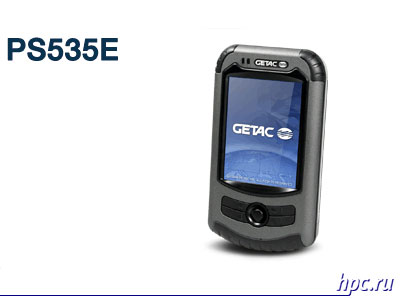 |
| Getac PS535E |
Industrial PDA WoongJin STM-8100 all subjected to water procedures directly to the manufacturer's booth at CeBIT 2008. The device is protected against dust and water, conforming to IP65, in addition udaroustoychiv communicator and able to work in temperatures ranging from -10 to +50 degrees Celsius. WoongJin STM-8100 operates in CDMA and GSM / GPRS / EDGE, supports Wi-Fi (802.11 b / g), Bluetooth 2.0, and also has GPS-functionality, a barcode scanner and so on. All this is based on the processor Intel PAX 320P with a frequency of 806 MHz, 1 GB of flash memory and 128 MB RAM, expandable to 256 MB.
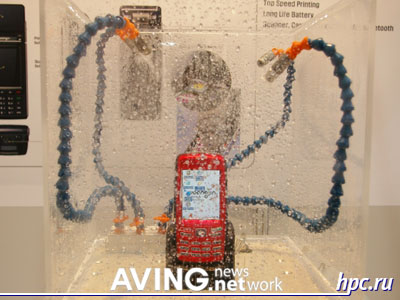 |
| WoongJin STM-8100 |
Legal Software for iPhone and iPod touch
Last week in addition to the exhibition CeBIT 2008, there was another important event of global importance. At a special event, Apple has officially announced a package for software developers for the iPhone. This will allow the creators of third-party applications for the revolutionary phone out of hiding and expand its functionality on a completely legal manner. At the moment before the beta version of iPhone SDK, it can be downloaded for free from Apple. The final release is expected in late June, in conjunction with the release of firmware iPhone 2.0. Applications from third-party developers will be controlled by Apple itself, and distributed only through the portal App Store, this will ensure stability, reliability and security of the iPhone. Developers of commercial software will deduct 30 percent of Apple sales, and free programs will remain so for free, including developers. True to start working with the App Store need to participate in the program, iPhone Developer Program over the standard version of the Standard Program for $ 99 a year, or by a variant Enterprise Program for $ 299 a year. The standard program provides access to development tools and the iPhone SDK, not yet released software for the iPhone, technical support, the ability to test code on the iPhone, and distribute applications through the App Store. Enterprises also can create the App Store private pages accessible only to employees.
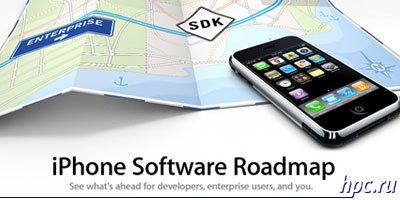 |
At the iPhone SDK includes the iPhone OS API, including interfaces for Core OS, Core Services, Media and Cocoa Touch, as well as tools for building applications, including Xcode for editing code, tools for project management and debug, Interface Builder to create interfaces using drag and drop, with the ability to preview, and tools for monitoring and optimizing application performance in real time, as well as emulator iPhone (currently only for Mac).
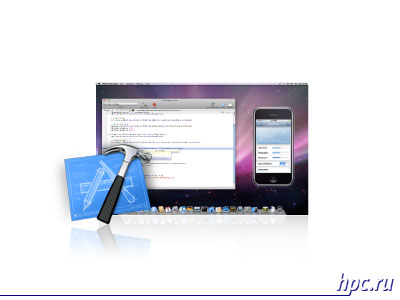 |
IPhone 2.0 firmware provides several advanced features not yet available on the phone Apple. For example, the iPhone is finally appears support for enterprise services based on Microsoft Exchange ActiveSync, including secure push email, access corporate contacts and calendar, as well as remote administration. iPhone 2.0 supports Cisco IPsec VPN, security certificates and the secure exchange of data on WPA2/802.11x. In addition to the networking features in iPhone 2.0 will have new features component Mail, such as the ability to view attachments in a PowerPoint presentation in addition to the already supported Word and Excel, mass delete or move mail. For the iPhone update will be free, but for the users player iPod touch it will be available for a small fee if they want to run a third-party applications on your player. Such a move Apple makes to the law, with a paid upgrade iPod touch users have already encountered with the release of firmware 1.1.3, which added 5 new applications. Regarding iPhone SDK as there is still a lot of questions. For example, do not be clarified nuance with applications that work with accessories that connect through the dock connector, there is uncertainty regarding restrictions on access to mobile phone capabilities, as well as what kind of content may seem priced Apple as an invalid for distribution through the App Store. In addition, it seems, is not yet supported multitasking. At present a clear answer to these questions, but there is no doubt that with time the situation becomes clearer. Already at the presentation of the intention to create applications for the iPhone and iPod touch announced several prominent companies, five of them showed developments created two weeks before the presentation. For example, Electronic Arts and Sega showed the game Spore and Super Monkey Ball, AOL showed the AIM-client adapted for the iPhone, Epocrates and Salesforce have shown the medical and business applications.
| Issue 3 - March 7, "width =" 400 "height =" 300 "/> |
Interestingly, for promising companies newcomers have already established a venture fund iFund for $ 100 million. Investments will be made into interesting projects to develop software for the iPhone and iPod touch, will first pay attention to applications for mobile commerce, social networking and location-based services. The authors, translation:










